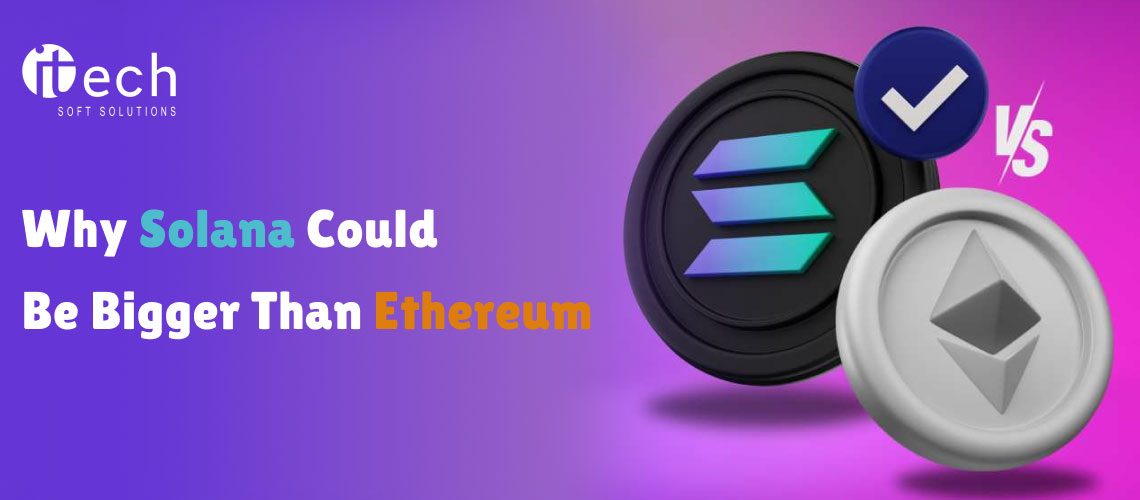In the fast-paced world of blockchain technology, Solana has emerged as a serious contender to challenge Ethereum’s dominance. With its unmatched transaction speeds, scalability, and lower transaction costs, Solana offers a compelling alternative to Ethereum.
Solana’s flourishing ecosystem, advanced technology stack, and growing institutional interest further bolster its potential for widespread adoption. As the demand for blockchain solutions continues to grow, Solana’s innovative approach positions it as a formidable competitor. With its ability to meet market demands in real-time, Solana could indeed be bigger than Ethereum shortly. Today, we will explore Why Solana could be bigger than Ethereum in the blockchain area.
Also Read:-
Pros and Cons of Solana Vs. Ethereum
Solana
Pros:
- High Transaction Speeds: Solana can process up to 65,000 transactions per second (TPS), far surpassing Ethereum’s 15-30 TPS.
- Scalability: Solana’s architecture allows for linear scalability, ensuring consistent performance even as the network grows.
- Low Transaction Costs: With transaction fees as low as a fraction of a cent, Solana offers a cost-effective alternative to Ethereum.
- Growing Ecosystem: Solana boasts a vibrant ecosystem of decentralized applications (dApps), decentralized finance (DeFi) protocols, and non-fungible token (NFT) projects.
- Advanced Technology Stack: Solana’s innovative technology stack, including features like Sealevel and Turbine, ensures efficient and fast transaction processing.
Cons:
- Less Established: While rapidly gaining traction, Solana is still relatively new compared to Ethereum, which may affect its long-term credibility.
- Centralization Concerns: Some critics argue that Solana’s consensus mechanism may lead to centralization, potentially compromising network security.
- Limited Adoption: Despite its impressive technology, Solana still lags behind Ethereum in terms of adoption and developer support.
Ethereum
Pros:
- Established Ecosystem: Ethereum boasts the largest and most established ecosystem of dApps, DeFi protocols, and NFT projects in the blockchain space.
- Smart Contract Functionality: Ethereum introduced the concept of smart contracts, allowing developers to create decentralized applications with custom logic.
- Decentralization: Ethereum’s Proof of Work (PoW) consensus mechanism promotes decentralization and network security.
- High Market Capitalization: Ethereum has the highest market capitalization of any blockchain platform, providing a high level of liquidity and stability.
Cons:
- Scalability Issues: Ethereum’s current scalability issues result in network congestion and high gas fees, limiting its usability for certain applications.
- Slow Transaction Speeds: Ethereum’s transaction speeds are significantly slower compared to Solana, with only 15-30 transactions per second.
- High Gas Fees: Ethereum’s gas fees can be prohibitively expensive during periods of network congestion, making it less accessible for users and developers.
- Transition to Ethereum 2.0: Ethereum’s transition to Ethereum 2.0 is still ongoing, with no guarantee of success, leaving uncertainty about its future scalability and performance.
Conclusion
While both Solana and Ethereum have their strengths and weaknesses, Solana’s impressive transaction speeds, scalability, and low transaction costs position it as a serious contender to challenge Ethereum’s dominance in the blockchain space.
However, Ethereum’s established ecosystem and decentralization remain significant advantages, making it a formidable competitor. As the blockchain space continues to evolve, it will be interesting to see how these two platforms compete and collaborate to drive innovation and adoption in the industry.



